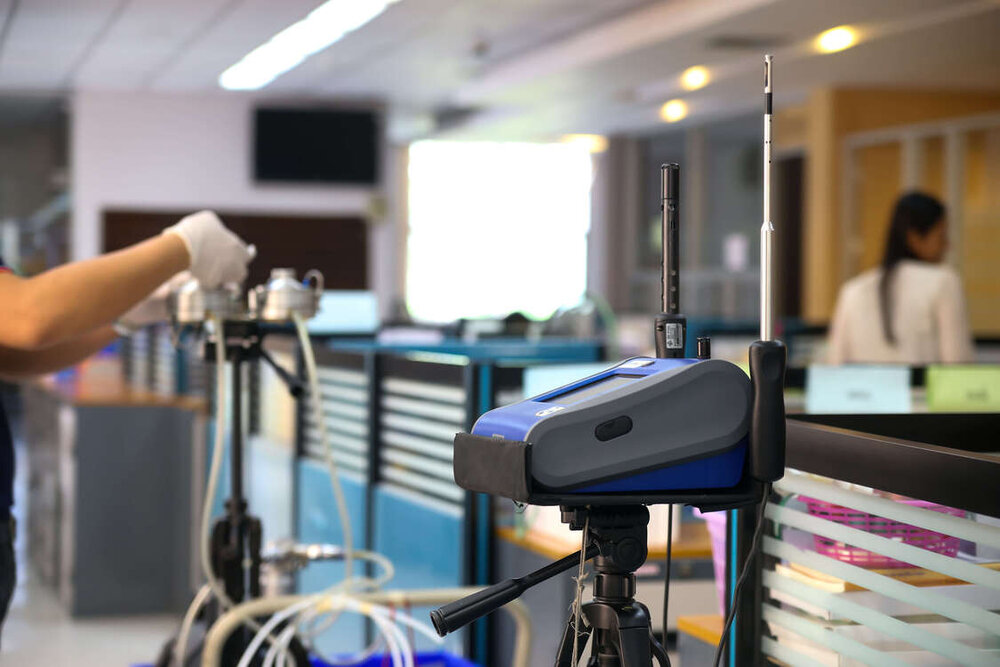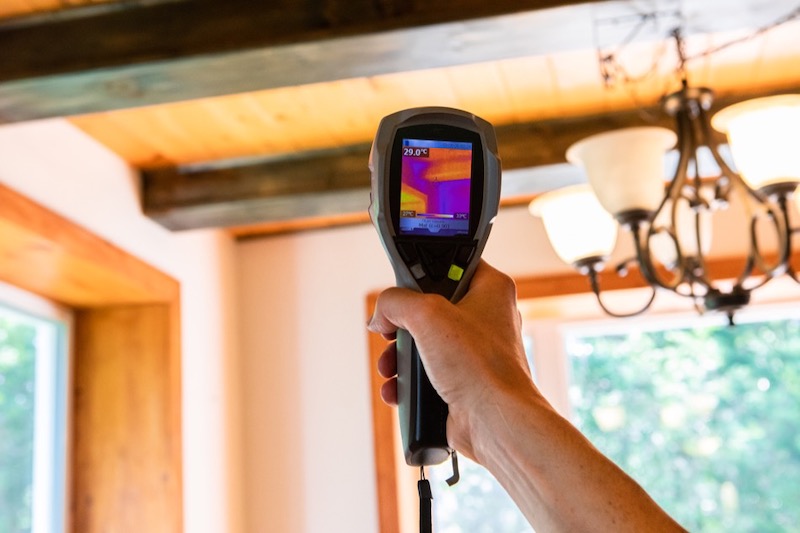For many of us, the air we breathe inside our homes is something we take for granted. Unfortunately, poor indoor air quality can seriously affect our health and the environment. From dust mites to mold spores, airborne pollutants can affect the quality of the air we breathe in our homes.
To help you assess the air condition in your home, we’ve put together this ultimate guide on how to test indoor air quality. We’ll cover everything from identifying pollutants to testing techniques and preventive measures. Let’s get started.
Importance Of Indoor Air Quality Testing
The reasons for testing the air quality inside your home, office, or other indoor environment are many, including:
1. Improved Health
Poor indoor air quality can lead to serious health issues, including allergies, asthma, and other respiratory illnesses. Testing your indoor air quality helps identify pollutants causing these symptoms — so you can take steps to improve it. Also, testing can help identify mold growth, which could lead to potentially dangerous health risks.
2. Increased Comfort
When air quality isn’t tested, you may find yourself in an environment with unpleasant odors that contribute to headaches and fatigue. By performing regular indoor air tests, you can ensure that the atmosphere inside is pleasant and comfortable.
3. Increased Efficiency
Testing your indoor air quality can also help you improve the efficiency of your HVAC system — reducing energy costs in the long run. By testing, you may discover problems with airflow or ventilation that could be solved (or supplemented) to save money and maximize comfort levels at home or work.
4. Increased Durability
Monitoring indoor air quality helps you spot problems before they become too costly to fix — so that your furniture, flooring, and other belongings will last longer. Testing can also help prevent more serious damage due to water leaks or moisture buildup.
Steps To Test Indoor Air Quality Inside Your Home
To ensure your family’s health and safety, here are a few steps to consider when testing for indoor air quality problems:
1. Purchase An Indoor Air Quality Monitor
To accurately measure the air quality in your home, you can purchase an indoor air quality monitor. These devices are designed to detect and quantify dust, pollen, mold, VOCs (Volatile Organic Compounds), CO2 (Carbon dioxide), and other harmful pollutants. Many modern monitors come with apps that provide real-time feedback on the air quality of your home.
Some essential features to look for when purchasing a monitor include:
- A display that is easy to read
- The ability to detect multiple pollutants
- An alarm that alerts you if the air quality falls below a certain level
- Remote access so you can view your data from anywhere
The sensors should be able to detect the smallest particles in the air, so you can be sure that your monitor is giving you a true representation of the air quality in your home.
- Humidity: Your sensor should also detect the humidity in the air. High moisture levels can lead to mold growth, which can be hazardous to your health.
- Temperature: An indoor air quality monitor should also be able to track the temperature in your home. If the levels are too high or too low, it can affect the air quality and create an uncomfortable environment.
- PM: Particulate matter (PM) is another pollutant that should be monitored. These are tiny particles that can enter your lungs and cause respiratory problems.
- AQI: The Air Quality Index (AQI) measures the overall air pollution in your home. It considers the levels of all pollutants and assigns a number to them. The higher the number, the worse the air quality in your home.
Ensure that you purchase an indoor air quality monitor that is certified and rated for accuracy. This will ensure that you can trust the data it provides.
2. Evaluate Health Symptoms
Once you have analyzed an indoor air quality monitor, the next step is to evaluate any health symptoms that could be related to the air quality in your home. Common indoor air pollutants like carbon monoxide, volatile organic compounds (VOCs), mold, and dust can lead to various health problems, from headaches and nausea to long-term diseases such as asthma and cancer.
To identify potential causes of your symptoms, pay attention to the time of day that your symptoms occur or if they coincide with any changes in air quality. Also, keep an eye out for any patterns in the symptoms that could give you information on what is causing them. Consider consulting a healthcare professional for advice if your health symptoms are severe.
3. Monitor Carbon Monoxide And Radon Levels
Carbon monoxide and radon are two of the most common indoor air pollutants that can pose health risks if not monitored properly. Also, they can be difficult to detect without the use of detection devices.
- Carbon monoxide is an odorless, colorless gas that can cause flu-like symptoms or even death if it builds up in an enclosed space.
- Radon is a naturally occurring radioactive gas found in some soils and rocks, and long-term exposure to high radon levels have been linked to an increased risk of certain cancers.
To ensure that your home is safe from the health risks associated with carbon monoxide and radon, the best way to test for these pollutants is to purchase a special indoor air quality monitor to measure their levels. These monitors are readily available online or in hardware stores, and they can alert you when levels of these pollutants become too high. They also provide a more accurate reading than single-use testing kits, so they are worth the investment if you want to ensure the safety of your home.
Do You Need Professional IAQ Testing?
If you’re concerned that your home’s air quality is not up to par, it may be time to look into professional IAQ testing. Professional tests offer more accurate results and a broader range of information than what is available with most consumer-grade monitors.
Professional tests can also evaluate the presence of other contaminants, such as mold spores, dust mites, formaldehyde, and volatile organic compounds. A qualified technician should do professional IAQ testing with special equipment to measure the levels of each contaminant present. This will provide you with an accurate picture of your home’s air quality so that you can make informed decisions on how best to improve it.

How To Mitigate Poor Air Quality In Your Home?
If you’re concerned about indoor air quality problems, it’s important to take proactive steps to improve air circulation and reduce pollutants. Here are a few key steps you can take:
1. Increase Ventilation
Open windows whenever possible to allow fresh outdoor air and stale indoor air out, especially when cooking and using harsh cleaning products. Make sure all room vents are open and change out the air filter in your furnace regularly. For the air conditioning system, clean or replace the filter regularly.
2. Remove Sources of Pollution
Where possible, remove sources of indoor pollution such as pet dander and smoke by frequently using odor-reducing cleaning products and vacuuming. If necessary, consider making your home a no-smoking zone. Using a HEPA air purifier to capture airborne particles may be a good solution for those with asthma or allergies.
3. Use Green Cleaners
The use of harsh chemical cleaners can exacerbate indoor air pollutants. Opt for green cleaning products free from VOCs and other harmful chemicals to avoid this. You can also stick to natural cleaning methods such as baking soda, white vinegar, and lemon juice.
4. Control Moisture Levels
Excessive humidity can lead to mold growth, a serious health risk. Use exhaust fans while cooking, showering, and laundry to help reduce moisture levels in the home. If you notice visible signs of mold, act quickly to tackle the problem with a bleach-water mixture and contact an expert if necessary.
5. Air Purifiers
Consider investing in an air purifier with a HEPA filter for more effective air purification. Many air purifiers can capture a wide range of airborne pollutants, including smoke particles and pet dander. Also, clean or replace the filter regularly for optimal performance.
6. Monitor Indoor Air Quality
The best way to keep on top of your indoor air quality is to monitor it regularly with an indoor air quality monitor that can alert you when levels are higher than normal. This can help detect problems such as radon and carbon monoxide, so you can take the appropriate steps to address them promptly.

FAQs
1. What Are The Symptoms Of Indoor Air Quality Problems?
The common symptoms of poor indoor air quality are frequent headaches, sore throat and eyes, coughing, sneezing, dizziness, fatigue, and stuffy nose. It is important to take these symptoms seriously as various pollutants like molds, dust mites, asbestos fibers, and more can cause them.
2. What Should I Do If The Air Quality Test Shows High Levels Of A Pollutant?
If the indoor air quality monitor shows high pollutant levels, the first step should be identifying and removing the source. This can include cleaning surfaces, replacing damaged materials, or consulting a professional. After removing the source, it is important to monitor the indoor air quality and ensure that it goes back to a safe level.
3. What Is The Cost Of Professional Air Quality Testing?
The cost of professional air quality testing will depend on the test type and your space size. A basic airborne pollutant test for a single room in a small home typically starts around $500, while a more comprehensive test that includes water, soil, and mold sampling can range up to $2,000 or more.
Conclusion
Identify and address air quality in your home or workspace today! Testing indoor air quality is essential to ensure that you and your family or coworkers breathe healthy, clean air. It may seem like a lot of effort, but knowing how to test indoor air quality correctly and taking action will go a long way in improving the overall health of everyone at home or in the office.
Regularly check your home or workspace for pollutants and make sure you’re using EPA-approved air purifiers, HVAC filters, and other solutions to keep the air clean at all times. Get these easy tips today and breathe the fresh air you deserve!


